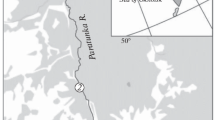Abstract
High concentrations of rare, trace, and rare-earth elements, which cannot exist outside the sphere of long-term active technogenesis, have been determined in the highly transformed anthropogenic water of the sulfide (ore) and sulfidized (coal and ore) deposits characterized by the sulfuric acid environment. It has been established that many deposits of the traditional raw materials can be considered rare metal water pools (liquid ore accumulations) because of high rare-earth element (REE) concentrations in water in the case of a sulfuric hydrolysis and stable anthropogenic water flow rates. The environment-controlling systems of anthropogenic solutions have been substantiated, the boundaries of the inorganic forms of element transportation have been determined, and the degrees of hydration of these elements and the geoenvironmental consequences have been studied.
Similar content being viewed by others
REFERENCES
Garrels, R. and Christ, Ch., Solutions, Minerals, and Equilibria, NewYork: Harper and Row, 1965, Translated under the title Rastvory, minerlay, ravnovesiya, Moscow: Mir, 1968.
Ivanov, V.V., Ekologicheskaya geokhimiya elementov (Environmental Geochemistry of Elements), Moscow: Nedra, 1994.
Kabata-Pendias, A. and Pendias, C., Trace Elements in Soils and Plants, Boca Raton, F.: CRC, 1985. Translated under the title Mikorelementy v pochvakh i rasteniyakh, Moscow: Mir, 1989.
Kashik, S.A. and Karpov, I.K., Fiziko-khimicheskaya teoriya obrazovaniya zonal'nosti v kore vyvetrivaniya (Physicochemical Theory of Formation of Zonality in the Weathering Crust), Novosibirsk: Nauka, 1978.
Krainov, S.R. and Shvets, V.M., Gidrogeokhimiya (Hydrogeochemistry), Moscow: Nedra, 1992.
Latimer, W.M., The Oxidation States of the Elements and Their Potentials in Aqueous Solutions, New York: Prentice-Hall, 1952. Translated under the title “Okislitekmnye sostoyzniya elementov i ikh potentsialy v vodnykh rastvorakh, Moscow: Izd. Inostr. Liter., 1954.
Moor, J. and Ramamoorthy, S., Heavy Metals in Natural Waters: Applied Monitoring and Impact Assessment, New York: Springer, 1984. Translated under the title Tyazhelye metally v prirodnykh vodakh, Moscow: Mir, 1987.
Nadeenko, V.G. et al., Puti ozdorovleniya vodoemov, prinimayushchikh stochnye vody gidrometallurgicheskikh proizvodstv tsvetnykh i redkikh metallov. Metodicheskie rekomendatsii (Ways for Enhancement of Water Bodies Receiving Wastewater from Hydrometallurgy Production of Non-Ferrous and Rare Metals. Guidelines), Sverdlovsk: Sred.-Ural. kn. izd-vo, 1979.
Naumov, G.B., Ryzhenko, B.N., and Khodakovskii, I.L., Spravochnik termodinamicheskikh velichin (Thermodynamic Data Handbook), Moscow: Atomizdat, 1971.
Perel'man, A.I., Geokhimiya (Geochemistry), Moscow: Vysshaya Shkola, 1979.
Smirnov, S.S., Zona okisleniya sul'fidnykh mestorozhdenii (Oxidation Zone in the Beds of Sulfides), Moscow: Akad. Nauk SSSR, 1955.
Tabaksblat, L.S., Izv. Vyssh. Uchebn. Zaved., Geol. Razv., 1992, no. 6, p. 80.
Tabaksblat, L.S., Izv. Akad. Nauk, Ser. Geogr., 1993, no. 3, p. 109.
Tabaksblat, L.S., Gidrokhim. Mater., 1994, vol. 111, p. 31.
Tabaksblat, L.S., Izv. vuzov. Gorn. zhurn, 1995, no. 5, p. 130.
Tabaksblat, L.S., Dokl. Ross. Akad. Nauk, 1998, vol. 361, no. 1, p. 97.
Tabaksblat, L.S., Doctoral (Geol.-Miner.) Dissertation, Tyumen: Tyumen State Oil and Gas University, 1999.
Tabaksblat, L.S., Fundamental'nye problemy vody i vodnykh resursov (Fundamental Problems of Water and Water Resources), Tomsk: Izd-vo NTL, 2000.
Tabaksblat, L.S. and Sakharova, V.M., Geologiya Kazakhstana (Geology of Kazakhstan), Alma-Ata: Izv. NAN Kazakhstana, 1994, no. 2, p. 71.
Tabaksblat, L.S. and Umarov, M.U., Vodn. Resur., 1991, no. 2, p. 57.
Yakovleva, M.N., Boksity, ikh mineralogiya i genezis (Bauxites, Their Mineralogy and Genesis), Moscow: USSR Academy of Sciences, 1958.
Author information
Authors and Affiliations
Rights and permissions
About this article
Cite this article
Tabaksblat, L.S. Specific Features in the Formation of the Mine Water Microelement Composition during Ore Mining. Water Resources 29, 333–345 (2002). https://doi.org/10.1023/A:1015640615824
Issue Date:
DOI: https://doi.org/10.1023/A:1015640615824




